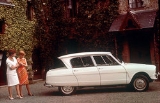
Citroën Ami
Encyclopedia
The Citroën Ami is a supermini
produced by the French automaker Citroën
from 1961 to 1978. The Ami and stablemate Citroën Dyane
were replaced by the Citroën Visa
and Citroën Axel
(the Axel was never sold in the UK). The Ami was for some years the best-selling car model in France. Production totalled 1,840,396 units.
Although not its commercial name, in France the Ami was often referred to as the Citroën 3CV Trois chevaux, or "three horses", CV originally being the initials for "cheval-vapeur" (horsepower), but used here for "chevaux fiscaux
" in short. The "cheval fiscal" was a French fiscal unit based on engine size ; smaller CV usually meant economical cars. The 602 cc engine of the Ami was fractionally above the upper limit for the 2 CV taxation class. The 3CV nickname differentiated the car in the market place from the long established Citroën 2CV
, but was never applied to the Ami 8, only to the Ami 6.
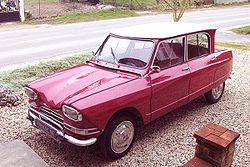
 As with Renault 4
As with Renault 4
, Citroën was responding to a market need for a vehicle slightly larger and less utilitarian and rustic than the 2CV. The Ami is a rebodied 2CV
with certain mechanical upgrades (particularly a larger engine than the 1950s 2cv), to compensate for the added weight. At launch all the cars were powered by an air cooled 602 cc two-cylinder flat engine
which was also offered at extra cost in the 2CV from 1961.
The platform chassis and suspension is similar to the 2CV, being independent all round using leading and trailing arms and coil springs interconnected front to rear. For a detailed suspension description see Citroën 2CV
.
The Ami's seats were easily removable. Sales pitches of the Ami included photographs of the seats being used as picnic chairs.
The Ami and the 1961 Ford Taunus
were the first vehicles with rectangular (as opposed to round) headlamps.
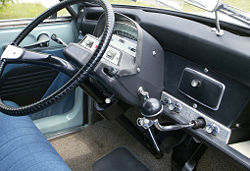


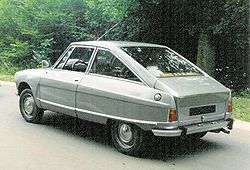 The car went on sale in France in the Spring of 1961, and already the manufacturer felt obliged to implement some simple upgrades in time for the October Paris Motor Show only six months later. The most visible upgrade involved the replacement of the fixed windows on the rear doors with two part horizontal sliding windows similar to those already fitted on the front doors. Nevertheless, sales in the early years seem to have been disappointingly low. The Ami's first full year of production was 1962, during which only 85,358 of the cars were sold, while the thirteen year old 2CV managed 144,759 sales during the same twelve month period. Although the Ami had a modern body, it shared the aggressively minimalist underpinnings of the older car, and in the market place this made it hard to justify for the Ami a starting price which, at the end of 1961, was 35% higher.
The car went on sale in France in the Spring of 1961, and already the manufacturer felt obliged to implement some simple upgrades in time for the October Paris Motor Show only six months later. The most visible upgrade involved the replacement of the fixed windows on the rear doors with two part horizontal sliding windows similar to those already fitted on the front doors. Nevertheless, sales in the early years seem to have been disappointingly low. The Ami's first full year of production was 1962, during which only 85,358 of the cars were sold, while the thirteen year old 2CV managed 144,759 sales during the same twelve month period. Although the Ami had a modern body, it shared the aggressively minimalist underpinnings of the older car, and in the market place this made it hard to justify for the Ami a starting price which, at the end of 1961, was 35% higher.
" rear screen fitted to the contemporary Mercury Monterey in the US, or the Ford Anglia
in the UK. A similar design feature is used on the current three door Citroën C4
.
The later Ami 8 saloon has a fastback
rear window. It was redesigned by the French car design and bodywork company, Heuliez. Most notable changes were the front part and bonnet and the sloping, rather than inverted, rear window on the saloon. The estate version of the Ami 8 had a similar general appearance to that of the Ami 6 although the later car's tail-lights were integrated into the rear wings.
The Ami Super was a flat-4
variant powered by the engine of the GS
and produced between 1973 and 1976.
At the launch of the GS, its original flat 4-cylinder air-cooled 1015 cc 55 bhp DIN engine was considered to be underpowered. With surplus engines available, Citroën decided to fit the engine into the Ami 8 in January 1973. The car, which became the Ami Super, then easily reached 140 km / h. From the outside, it had a new front grille and the four additional vents underneath. On the sides of the front wing there was a badge marked 1015 in reference to the new engine. The body is the same but the sheet is thicker (12/10e in mm), which helps the engine to the overall increase in mass. The suspension was equipped with two anti-roll bars. The tires are size 135R15 while Ami retain 125R15. The iodine headlamps are optional. Inside, the gear change is floor mounted, the hand brake is in a central position in place of the gear lever of the Ami 8, a plusher interior differentiates from the Ami 8. The Ami Super was considered too narrow for its engine size. In addition, it was not was too close in exterior looks to the basic Ami 8. As a result, to differentiate the Citroën Ami Super a band of side decorative chrome work and wheels were added for 1974. The Ami Super production reached close to 42,000 in sedan and station wagon by February 1976.
A small series of prototype coupé
s, the M35
were produced as test vehicles for loyal customers — testing the single-rotor Comotor
Wankel engine
, as also seen in the NSU Spider
. A twin-rotor version of this engine reached production form with the NSU Ro 80
and GS Birotor
.
opened in 1961 in the presence of the new president
to the south-west of
central Rennes
. It was later joined at the plant by the Dyane
and GS
models.
in 1962 had a top speed of 65.3 mph (105.1 km/h) and could accelerate from 0-50 mph (80.5 km/h) in 30.3 seconds. A fuel consumption of 53 mpgimp was recorded. The test car cost £823 including taxes on the UK market.
Supermini car
A supermini is a British term that describes automobiles larger than a city car but smaller than a small family car. This car class is also known as the B-segment across Europe, and as subcompact in North America....
produced by the French automaker Citroën
Citroën
Citroën is a major French automobile manufacturer, part of the PSA Peugeot Citroën group.Founded in 1919 by French industrialist André-Gustave Citroën , Citroën was the first mass-production car company outside the USA and pioneered the modern concept of creating a sales and services network that...
from 1961 to 1978. The Ami and stablemate Citroën Dyane
Citroën Dyane
The Citroën Dyane is an economy car/supermini produced by the French automaker Citroën from 1967 to 1983. Based on the Citroën 2CV, 1,444,583 examples were manufactured...
were replaced by the Citroën Visa
Citroën Visa
The Citroën Visa is a supermini that was produced by the French car marque Citroën from 1978 to 1988.-Development History:The Citroën Prototype Y to replace the 2CV based Citroën Ami that dated back to 1960 in the early seventies, was originally developed in co-operation with Fiat...
and Citroën Axel
Citroën Axel
The Citroën Axel was a supermini automobile produced between 1984 and 1990 and developed in co-operation by Citroën of France and Automobile Craiova, a joint venture company with the Romanian government....
(the Axel was never sold in the UK). The Ami was for some years the best-selling car model in France. Production totalled 1,840,396 units.
Although not its commercial name, in France the Ami was often referred to as the Citroën 3CV Trois chevaux, or "three horses", CV originally being the initials for "cheval-vapeur" (horsepower), but used here for "chevaux fiscaux
Tax horsepower
The tax horsepower or taxable horsepower was an early system by which taxation rates for automobiles were reckoned in some European countries, such as Britain, Belgium, Germany, France, and Italy; some US states like Illinois charged license plate purchase and renewal fees for passenger...
" in short. The "cheval fiscal" was a French fiscal unit based on engine size ; smaller CV usually meant economical cars. The 602 cc engine of the Ami was fractionally above the upper limit for the 2 CV taxation class. The 3CV nickname differentiated the car in the market place from the long established Citroën 2CV
Citroën 2CV
The Citroën 2CV |tax horsepower]]”) was an economy car produced by the French automaker Citroën between 1948 and 1990. It was technologically advanced and innovative, but with uncompromisingly utilitarian unconventional looks, and deceptively simple Bauhaus inspired bodywork, that belied the sheer...
, but was never applied to the Ami 8, only to the Ami 6.
Overview


Renault 4
The Renault 4, also known as the 4L , is a hatchback economy car produced by the French automaker Renault between 1961 and 1992. It was the first front-wheel drive family car produced by Renault....
, Citroën was responding to a market need for a vehicle slightly larger and less utilitarian and rustic than the 2CV. The Ami is a rebodied 2CV
Citroën 2CV
The Citroën 2CV |tax horsepower]]”) was an economy car produced by the French automaker Citroën between 1948 and 1990. It was technologically advanced and innovative, but with uncompromisingly utilitarian unconventional looks, and deceptively simple Bauhaus inspired bodywork, that belied the sheer...
with certain mechanical upgrades (particularly a larger engine than the 1950s 2cv), to compensate for the added weight. At launch all the cars were powered by an air cooled 602 cc two-cylinder flat engine
Flat engine
A flat engine is an internal combustion engine with multiple pistons that move in a horizontal plane. Typically, the layout has cylinders arranged in two banks on either side of a single crankshaft and is sometimes known as the boxer, or horizontally opposed engine. The concept was patented in 1896...
which was also offered at extra cost in the 2CV from 1961.
The platform chassis and suspension is similar to the 2CV, being independent all round using leading and trailing arms and coil springs interconnected front to rear. For a detailed suspension description see Citroën 2CV
Citroën 2CV
The Citroën 2CV |tax horsepower]]”) was an economy car produced by the French automaker Citroën between 1948 and 1990. It was technologically advanced and innovative, but with uncompromisingly utilitarian unconventional looks, and deceptively simple Bauhaus inspired bodywork, that belied the sheer...
.
The Ami's seats were easily removable. Sales pitches of the Ami included photographs of the seats being used as picnic chairs.
The Ami and the 1961 Ford Taunus
Ford Taunus P3
The Ford Taunus 17 M was a middle sized family saloon/sedan produced by Ford of Germany between 1960 and 1964. The Taunus 17M name had been applied to the car’s predecessor and it would apply also to subsequent Ford models which is why the 17M introduced in 1960 is usually identified, in...
were the first vehicles with rectangular (as opposed to round) headlamps.
Market reaction




Versions
The Ami 6 sedan is distinguished by an unusual reverse-raked rear window, similar to the "BreezewayBreezeway
A breezeway is an architectural feature similar to a hallway that allows the passage of a breeze between structures to accommodate high winds, allow aeration, or provide aesthetic design variation. Often a breezeway is a simple roof connecting two structures ; sometimes it can be much more like a...
" rear screen fitted to the contemporary Mercury Monterey in the US, or the Ford Anglia
Ford Anglia
The 1949 model, code E494A, was a makeover of the previous model with a rather more 1940s style front-end, including the sloped, twin-lobed radiator grille. Again it was a very spartan vehicle and in 1948 was Britain's lowest priced four wheel car....
in the UK. A similar design feature is used on the current three door Citroën C4
Citroën C4
The Citroën C4 is a small family car produced by French automaker Citroën since autumn 2004. The C4 was designed to be the successor to the Citroën Xsara. It is mechanically similar to the Peugeot 308, which was launched in 2007. A revised version with new front end, reverse light and dashboard...
.
The later Ami 8 saloon has a fastback
Fastback
A fastback is a car body style whose roofline slopes continuously down at the back. The word can also designate the car itself. The style is seen on two-door coupés as well as four-door sedans.-History:...
rear window. It was redesigned by the French car design and bodywork company, Heuliez. Most notable changes were the front part and bonnet and the sloping, rather than inverted, rear window on the saloon. The estate version of the Ami 8 had a similar general appearance to that of the Ami 6 although the later car's tail-lights were integrated into the rear wings.
The Ami Super was a flat-4
Flat-4
A flat-4 or horizontally opposed-4 is a flat engine with four cylinders arranged horizontally in two banks of two cylinders on each side of a central crankcase...
variant powered by the engine of the GS
Citroën GS
The Citroën GS and Citroën GSA are small family cars produced by the French automaker Citroën. The GS was voted European Car of the Year for 1971, and was probably the most technologically advanced car in its class when launched, with class leading comfort, safety and aerodynamics.-Market...
and produced between 1973 and 1976.
At the launch of the GS, its original flat 4-cylinder air-cooled 1015 cc 55 bhp DIN engine was considered to be underpowered. With surplus engines available, Citroën decided to fit the engine into the Ami 8 in January 1973. The car, which became the Ami Super, then easily reached 140 km / h. From the outside, it had a new front grille and the four additional vents underneath. On the sides of the front wing there was a badge marked 1015 in reference to the new engine. The body is the same but the sheet is thicker (12/10e in mm), which helps the engine to the overall increase in mass. The suspension was equipped with two anti-roll bars. The tires are size 135R15 while Ami retain 125R15. The iodine headlamps are optional. Inside, the gear change is floor mounted, the hand brake is in a central position in place of the gear lever of the Ami 8, a plusher interior differentiates from the Ami 8. The Ami Super was considered too narrow for its engine size. In addition, it was not was too close in exterior looks to the basic Ami 8. As a result, to differentiate the Citroën Ami Super a band of side decorative chrome work and wheels were added for 1974. The Ami Super production reached close to 42,000 in sedan and station wagon by February 1976.
A small series of prototype coupé
Coupé
A coupé or coupe is a closed car body style , the precise definition of which varies from manufacturer to manufacturer, and over time...
s, the M35
Citroën M35
The Citroën M35 was a coupé derived from the Ami 8, and equipped with a Wankel engine and a hydropneumatic suspension. The bodies were produced by Heuliez from 1969 to 1971....
were produced as test vehicles for loyal customers — testing the single-rotor Comotor
Comotor
The Company Comotor SA was a joint venture between NSU and Citroën, created in Luxembourg in April 1967. Its goal was to produce Wankel engines....
Wankel engine
Wankel engine
The Wankel engine is a type of internal combustion engine using an eccentric rotary design to convert pressure into a rotating motion instead of using reciprocating pistons. Its four-stroke cycle takes place in a space between the inside of an oval-like epitrochoid-shaped housing and a rotor that...
, as also seen in the NSU Spider
NSU Spider
The NSU Spider was the first production car in the world to be powered by a Rotary Wankel engine.Apart from its water-cooled single rotor engine, the car was in most respects unremarkable...
. A twin-rotor version of this engine reached production form with the NSU Ro 80
NSU Ro 80
The NSU Ro 80 was a technologically advanced large sedan-type automobile produced by the German firm of NSU from 1967 until 1977. Most notable was the powertrain; a , 995 cc twin-rotor Wankel engine driving the front wheels through a semi-automatic transmission employing an innovative vacuum system...
and GS Birotor
Citroën GS
The Citroën GS and Citroën GSA are small family cars produced by the French automaker Citroën. The GS was voted European Car of the Year for 1971, and was probably the most technologically advanced car in its class when launched, with class leading comfort, safety and aerodynamics.-Market...
.
French production
The Ami 6 was the first model to be produced at the new Citroen plantPSA Rennes Plant
The PSA Rennes Plant is one of the principal car plants in France, producing approximately 340,000 cars in 2005. The plant was acquired by the PSA Group in 1976 when Peugeot took a majority stake in the Citroën company which had built the plant but then run out of money...
opened in 1961 in the presence of the new president
Charles de Gaulle
Charles André Joseph Marie de Gaulle was a French general and statesman who led the Free French Forces during World War II. He later founded the French Fifth Republic in 1958 and served as its first President from 1959 to 1969....
to the south-west of
Chartres-de-Bretagne
Chartres-de-Bretagne is a commune in the Ille-et-Vilaine department of Brittany in north-western France.-Demographics:Inhabitants of Chartres-de-Bretagne are called in French Chartrains.As of the census of 1999, the town had a population of ....
central Rennes
Rennes
Rennes is a city in the east of Brittany in northwestern France. Rennes is the capital of the region of Brittany, as well as the Ille-et-Vilaine department.-History:...
. It was later joined at the plant by the Dyane
Citroën Dyane
The Citroën Dyane is an economy car/supermini produced by the French automaker Citroën from 1967 to 1983. Based on the Citroën 2CV, 1,444,583 examples were manufactured...
and GS
Citroën GS
The Citroën GS and Citroën GSA are small family cars produced by the French automaker Citroën. The GS was voted European Car of the Year for 1971, and was probably the most technologically advanced car in its class when launched, with class leading comfort, safety and aerodynamics.-Market...
models.
Spanish production
The Ami 6 & Ami 8 were also built by Citroën Hispania in Vigo (Spain) from 1967 to 1978, but they were never called "Ami" because of a legal problem with that name. The equivalences with French built models are:- Ami 6 berline: never built in Spain.
- Ami 6 break old model (M4 type engine): Citroën Break 3cv.
- Ami 6 break new model (M28 type engine): Citroën Dynam.
- Ami 8 berline: Citroën 8 or C-8.
- Ami 8 break: Citroën 8 Familiar or Citroën Familiar.
Performance
An Ami 6 tested by the British magazine The MotorThe Motor (magazine)
The Motor was a British weekly car magazine founded on 28 January 1903....
in 1962 had a top speed of 65.3 mph (105.1 km/h) and could accelerate from 0-50 mph (80.5 km/h) in 30.3 seconds. A fuel consumption of 53 mpgimp was recorded. The test car cost £823 including taxes on the UK market.
Model Changes in detail
The following table summarises information to distinguish Ami Models.| Years | image | type | Model Changes |
|---|---|---|---|
| 1961 | 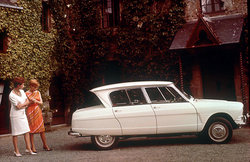 |
AM | Launch in April. |
| 1962 | AM | Sliding rear windows (one half only). | |
| 1963 | AM | Version for export to the United States: double round headlights, front turn signals round, additional chrome bumpers, grille and stainless steel license plate closer. Engine 26 hp instead of 22 hp. Hydraulic dampers. Suspended Brake and clutch pedals. |
|
| Nov 1964 | AMB AMF AMC | Estate body type. New rear light units. | |
| Oct 1967 |  |
AMBPA | Estate Club model. Twin round headlights. Improved finish. |
| May 1968 |  |
AM2 AMB2 | M28 engine of 35 hp at 5750 rev / min. Double sliding front windows. Trapezoidal taillamps. |
| March 1969 | AM3 | The Ami 8 replaces the Ami 6. | |
| July 1969 | AMJA AMJB | The Ami 8 receives disc brakes on the front. The hydraulic system works with LHM fluid. | |
| Sept 1969 | AMB3 AMC3 |
Ami 8 estate launched. | |
| Jan 1973 | AMJF AMJG AMJH |
Launch of the Ami Super. |
Production figures
Production of the Ami, all models except M35, is according to the manufacturer's data is 1,840,121 total production. It is divided between the models as follows:| Model | Ami 6 Berline/Saloon |
Ami 6 Break/Estate |
Ami 6 Service Van |
Ami 8 Berline/Saloon |
Ami 8 Break/Estate |
Ami 8 Service Van |
Ami Super Berline/Saloon |
Ami Super Break/Estate |
Ami Super Service Van |
|---|---|---|---|---|---|---|---|---|---|
| Reference Code. | AM AM2 |
AMB AM2B |
AMC(2) AMF(2) |
AM3 |
AMB3 AMJB |
AMC3 AMJC |
AMJF |
AMJG |
AMJH |
| Production | 483 986 |
551 880 |
3 518 |
342 743 | 386 582 | 26 630 | 24 797 |
19 222 |
801 |

